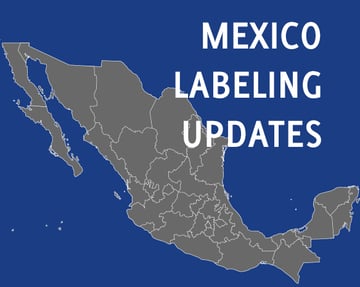Updated nutrition labeling regulations for Mexico became final on March 27, 2020, and will be rolled out in three implementation phases. To assist with compliance, ESHA has incorporated these regulations into the last version of Genesis R&D Foods. Learn more.
Overview of the Regulations
At the beginning of Phase 1, manufacturers must include the new front-of-package (FOP) warning symbols and statements on all product packaging (some exemptions apply). Again, because of the small implementation window, the symbols can be affixed to the package as stickers until April 1, 2021. From Oct. 1, 2020, through March 31, 2021, packages may show existing Nutrition Facts and FOP guidelines as long as they also include the new FOP warning symbols and statements.
After April 1, 2021, the changes to the Nutrition Facts, ingredient statement, allergen statements, and the FOP symbols and statements must be implemented on all packaging.
Phase 1 includes:
- Updated FOP warning seals and statements (replacing current icons)
- Added Sugars grouped by weight in the Ingredient Statement
- Updated list of allergens
- Added Sugars and Trans Fat as a mandatory label nutrients
- Modified declarations requirements for voluntary nutrients
- Changes to the label format
Implementation Dates
- Phase 1 — Oct. 1, 2020* – Sept. 30, 2023
- Phase 2 — Oct. 1, 2023 – Sept. 30, 2025
- Phase 3 — On and after Oct. 1, 2025
*Note: Due to the short implementation timeline for manufacturers to use existing inventory, the enforcement date has been delayed to Nov. 30, 2020.
FOP Warning seals
New warning seals and statements will replace the current FOP icons. Manufacturers will have to determine which of these nutrients [Energy (kcal), Sugars, Saturated Fats, Trans Fats, Sodium] exceed the recommended intake thresholds. This is a new requirement. All seals that apply should be listed on the package, and small packages can use a number to signify how many seals apply.
The original FOP (front-of-package) icons were designed to inform consumers of the amounts of selected nutrients and proximates. In contrast, the new FOP icons warn consumers when the amounts exceed intake recommendations for Calories, Total Sugar, Saturated Fat, Trans Fat, and/or Sodium.
The warning symbols look like this:

and must comply with the following layout specs:
- Shape: Regular octagon
- Background color: Black with white outline
- Font: Arial Bold in white, to contrast with the background.
- Placement: Primary Display Panel (almost always the front)
Warning Statements
The packaging design changes also call for warning statements when the product contains “non-nutritive” sweeteners and caffeine.
- Products that contain caffeine must include the warning “CONTIENE CAFEÍNA — EVITAR EN NIÑOS” (“Contains caffeine — children should avoid”).
- Products that contain sweeteners must include the warning “CONTIENE EDULCORANTES — NO RECOMENDABLE EN NIÑOS” (“Contains sweeteners — not recommended for children”).
Label Layout
The label header says Declaracion Nutrimental (Nutritional Declaration), which is a change from the previous Informacion Nutrimental (Nutritional Information), and reporting calories per package is now required for all labels.
Two nutrients are now mandatory: Grasas trans (Trans fat) and Azucares añadidos (Added Sugars). They must be displayed on the label in bold, along with existing mandatory nutrients: Contenido energético (Calories), Grasas saturadas (Saturated Fat), and Sodio (Sodium).
Other label layout specifications (font size and rule width) remain consistent with the previous version.
Nutrient Changes
Sugars
Azucares añadidos (Added Sugars) are defined as “Sugars added during the industrial process” and differentiated from Azucares (Free Sugars), which are defined as “available mono and disaccharides added to the product plus naturally occurring sugars in honey, fruit, vegetables.” Both are mandatory on the label, Azucares añadidos newly so.
Sugars, however, also differ from Sweeteners, which, again, appear on the front of the package. Those are defined as “Generally non-nutritive sweeteners, substances different from mono and disaccharides that provide sweet flavor to products.”
Trans fat
Trans fat now a mandatory label nutrient and is reported in milligrams instead of grams.
Voluntary Nutrients
Some nutrients have changed units. They are:
| NUTRIENT | OLD UNIT | NEW UNIT |
| Vitamin B1 | mg | µg |
| Vitamin B2 | mg | µg |
| Vitamin B6 | mg | µg |
| Copper | mg | µg |
Ingredient statements
Ingredients listed in descending order of predominance by weight and composite ingredients must disclose sub-ingredients in parenthesis when they represent more than 5% of the product.
When Added Sugars are used in the product, the ingredient statement must group them together and display “Added sugars” followed by a list of the specific names, listed by weight, in parenthesis.
Allergens
If the product contains any of these allergens, they must be listed after the ingredient statement in bold font:
- Gluten
- Crustaceans and products
- Eggs and byproducts
- Fish and byproducts
- Milk/dairy
- Soy and byproducts
- Tree nuts and peanuts
- Sulfites
- Molluscs (newly added allergen)
Tree nuts must be listed by specific type. Example: Almonds, walnuts, hazelnuts, pecans, etc.
When contamination is possible during production, the label must use a “may contain” statement.
Other posts you might be interested in
View All Posts
Food Labeling
30 min read
| November 8, 2020
Creating Mexico Front-of-Package Warning Seals and Statements
Read More
Food Labeling
19 min read
| January 19, 2024
Mexico’s Front-of-Pack Nutrition Labeling Phase 2 vs Phase 3
Read More
Food Labeling
4 min read
| December 14, 2016

